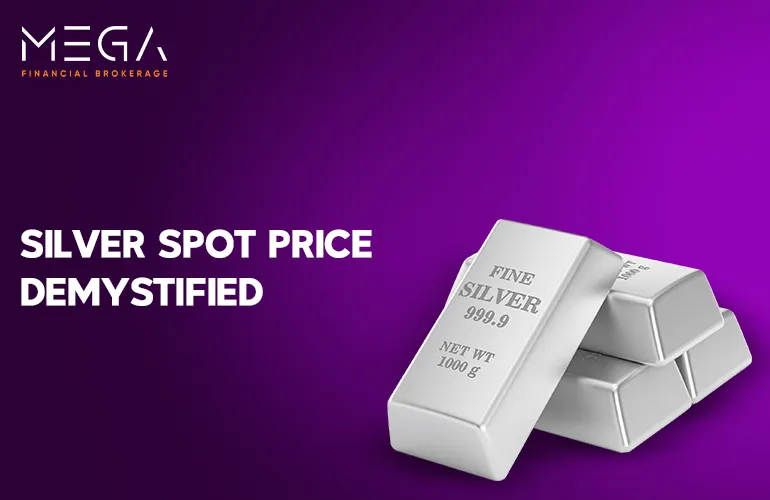Today, staying on top of live market prices is crucial for traders and that’s where the silver spot price plays a key role. It shows the price of one ounce of silver right now, when it is traded immediately and without any commitments for future delivery. This real-time price isn’t just informative; it’s actionable for traders.
Whether you’re analyzing silver prices today or watching how silver stacks up against metals like copper, understanding what moves the spot price can help sharpen your trading decisions. In this article, we’ll break down what drives these prices, how to track silver prices today, and why we understand these fluctuations.
What is the Silver Spot Price and Why Does it Matter in Trading?
The silver spot price is essentially the going rate for silver if you were to buy or sell it right this second.
- It’s not about future contracts or delivery dates; it’s about what silver is worth in real-time and right now across global markets.
- This price isn’t just a number; it’s a crucial reference point that guides every move for traders.
- It acts like a compass in the fast-moving world of commodities trading, helping them decide when to enter or exit a position.
Whether you’re scalping the market or planning a short-term swing trade, knowing the silver prices today helps you stay ahead of the curve. A sudden spike might hint at a breakout opportunity, while a sharp drop could signal a pullback worth riding. In short, the spot price keeps traders grounded, giving them the live snapshot they need to make smart, timely decisions because in trading, even seconds can make a difference.
Key Factors Influencing the Silver Spot Price in Commodity Trading
The silver spot price is shaped by a mix of real-world forces, from global economies to industrial needs. And for traders, understanding these factors is essential. Let’s break it down.
- Supply and Demand
The basic rule of thumb in trading is that if demand goes up and supply can’t keep up, prices will rise. Silver supply often depends on other metal mining, making it less flexible. At the same time, silver is a workhorse in industries like tech and healthcare. Add investor demand during shaky times, and you’ve got a recipe for big price moves. Speculators jumping in only heat things up more.
- Macroeconomic Factors
Big economic shifts play a major role in silver’s value. Inflation often pushes people toward silver as a hedge, especially when cash loses buying power. Low interest rates make silver more appealing since it doesn’t earn interest. And when the Demand is fueled by silver’s global affordability as the dollar declines. On the flip side, strong economic growth boosts industrial demand, while recessions cool things off.
- Geopolitical Events
Global uncertainty makes silver attractive. Whether it’s political unrest or military conflict, traders tend to rush into safe-haven assets like silver. Trade wars and shifting policies can also throw a wrench into supply chains or mining regulations, both of which can shake up the price.
- Market Sentiment and Speculation
Emotions move markets just as much as numbers do. When traders feel confident, they buy more silver. When doubt creeps in, they sell. Add in speculative trading driven by:
- News
- Social Media
- Silver Prices
These can swing dramatically in the short term, regardless of the fundamentals.
- Other Influences
Exchange rates, especially in countries like India, affect local silver prices. If the dollar gets stronger against the rupee, silver becomes more expensive there. Central bank decisions also have ripple effects, particularly when adjusting interest rates or inflation targets. Additionally, festival seasons in some locations increase the demand for silver momentarily, which raises the price.
How to Track Silver Prices Today for Effective Trading?
Keeping an eye on silver prices today is like having a GPS for your trading journey. For short-term traders, real-time silver spot price updates help catch those fleeting opportunities when prices swing, allowing you to buy low and sell high before the market shifts again. Long-term investors use these daily price checks to spot trends and decide the best times to hold or add to their positions.
To make the most of this data, integrate live spot prices into your trading toolkit by using trusted platforms and apps that offer real-time charts, customizable alerts, and market news. This way, you’re not just guessing; you’re making informed decisions backed up-to-the-minute info.
Comparing Silver Spot Price with Copper
When it comes to trading metals, silver and copper, often they all move in the same general direction, but they don’t always walk hand in hand. Silver, known for its dual role as both a precious and industrial metal, tends to react to economic uncertainty and monetary shifts, while copper is more of an economic thermometer.
Its price rises when industries are booming and dips when growth slows. That’s why smart traders keep an eye on copper’s moves to catch early signs of what might be brewing in the silver spot price. If copper starts climbing steadily, it could hint at stronger industrial demand, which might eventually also lift silver. But if the two break from their usual pattern. It can signal a shift, creating unique opportunities for those looking to hedge or trade the spread.
Conclusion
The silver spot price is a clue and occasionally a warning light in the hectic world of trading. By understanding what drives it, how it compares to metals like copper, and how to track it in real-time, traders can make sharper, more confident decisions. Whether you’re in it for quick moves or long-term plays, staying tuned in to Silver’s live price action can give you that extra edge.
Start tracking market moves like a pro with Mega Financial Brokerage and stay ahead, stay informed.

